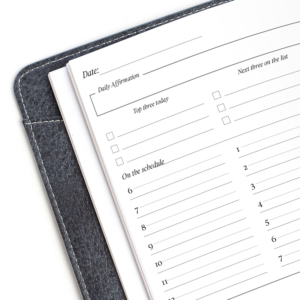Hey, Chaos Coordinators! Are you ready to level up your time management game and reclaim control of your schedule? Buckle up because we’re diving deep into the art of creating a time inventory (time diary, time audit…whatever you want to call it), and trust me, this is a game-changer.
Picture this: you’re juggling a million tasks, and somehow, the day still slips away faster than you can say “coffee break.” Sound familiar? Do you ever look back on the day with your to-do list half done and wonder where the time went? Well, fear not, because a time inventory is here to save the day.
So, what exactly is a time inventory? It’s like taking a magnifying glass to your daily routine and dissecting every minute of your day. It’s about understanding where your time goes, identifying inefficiencies, and ultimately, taking back the reins of your schedule.
Maybe the idea of that makes you cringe because you already know some of where your time goes… mindless scrolling on social media, games on your phone, Pinterest rabbit holes…and the list can go on and on, I’m sure. This activity isn’t meant to shame you or make you feel bad. It is 100% a data collection exercise to help you make decisions about where you WANT to be spending your time and highlight the pitfalls that you might tend to fall into.
Now, let’s talk benefits, shall we?
1. Visibility:
Creating a time inventory gives you a bird’s eye view of how you spend your time. It’s like turning on a spotlight in the dark corners of your schedule, revealing patterns and habits you may not have been aware of.
-
- Spotting Time Drains: You might realize that you spend more time on social media than you thought, which could be eating into your productivity during work hours.
- Identifying Peak Productivity Times: By tracking your activities, you might notice that you’re most focused and energetic in the morning, prompting you to schedule important tasks during that time for optimal performance. Or perhaps, you’re a night owl and find your productivity after the sun has gone down.
- Noticing Procrastination Patterns: You might discover that you tend to procrastinate on certain tasks, such as responding to emails or tackling big projects, and can then implement strategies to overcome this habit. Or, if you’re like me, you’re hitting the snooze button instead of getting up for that early morning workout. But I’m working on it!!
- Recognizing Overcommitment: Tracking your time can reveal instances where you’ve overcommitted yourself, such as scheduling back-to-back meetings or appointments, leading to burnout and decreased effectiveness. There need to be open blocks of time where you can just rest. Remember, when you say “yes” to one thing, that means you are saying “no” to something else – this is going to highlight what you are saying “no” to when you commit yourself to something new.
- Uncovering Time for Self-Care: On the flip side, you might realize that you have more free time than you thought, allowing you to intentionally carve out time for self-care activities like exercise, hobbies, or spending time with loved ones.
2. Efficiency:
Ever feel like you’re constantly busy but never really accomplishing much? A time inventory helps you pinpoint time-wasting activities and streamline your schedule for maximum productivity.
-
- Identifying Time Wasters: You might discover that you spend an excessive amount of time checking emails or attending meetings that could have been handled more efficiently, allowing you to implement strategies to limit these activities.
- Streamlining Workflows: By tracking your time, you might notice inefficiencies in your workflow, such as duplicating efforts or working on tasks that could be automated. This insight can help you streamline processes and eliminate unnecessary steps to work more efficiently.
- Prioritizing Tasks: With a clear understanding of how you spend your time, you can prioritize tasks based on their importance and urgency, ensuring that you’re focusing your energy on activities that drive the most significant results.
- Setting Realistic Goals: Tracking your time allows you to accurately assess how long tasks take to complete, helping you set more realistic deadlines and avoid overcommitting yourself.
- Optimizing Downtime: You might discover pockets of downtime throughout your day that can be utilized more effectively. Whether it’s waiting for a meeting to start or commuting, you can use this time to tackle smaller tasks or engage in activities that recharge your energy.
3. Prioritization:
By seeing where your time goes, you can prioritize tasks that align with your goals and values. Say goodbye to busywork and hello to meaningful progress.
-
- Identifying High-Impact Activities: Through your time inventory, you might realize that certain tasks or projects contribute more significantly to your long-term goals than others. This insight allows you to prioritize activities that align with your aspirations and have a greater impact on your success.
- Focusing on Important vs. Urgent: By tracking your time, you can distinguish between tasks that are important (aligned with your goals) and those that are merely urgent (demanding immediate attention but not necessarily contributing to your long-term objectives). Prioritizing important tasks ensures that you’re working on activities that move you closer to your desired outcomes.
- Eliminating Busywork: Your time inventory might reveal activities that consume a significant portion of your day but don’t contribute meaningfully to your goals. By identifying and eliminating busywork, you free up time and mental bandwidth to focus on tasks that drive progress and fulfillment.
- Allocating Resources Wisely: With a clear understanding of where your time is spent, you can allocate resources—such as time, energy, and attention—more effectively. This allows you to invest in activities that offer the greatest return on investment and bring you closer to achieving your objectives.
- Balancing Short-Term and Long-Term Goals: Your time inventory helps you strike a balance between short-term demands and long-term aspirations. While immediate tasks may require attention, prioritizing activities that align with your values and long-term vision ensures that you’re making steady progress toward your goals.
If you need additional help with prioritization of tasks, check out these articles:
Mastering Prioritization: The MoSCoW Method for Busy Working Moms
Mastering Your Week: A Guide to Crafting a Prioritized To-Do List
Mastering Time Management: The Eisenhower Matrix
4. Mindfulness:
Becoming aware of how you spend your time fosters mindfulness. You’ll start making intentional choices about how to allocate your most precious resource.
- Conscious Time Allocation: Through the process of tracking your time, you become more aware of how each moment is spent. This heightened awareness encourages you to make conscious choices about how to allocate your time, ensuring that it aligns with your priorities and values.
- Reducing Multitasking: Mindful time tracking helps you recognize the detrimental effects of multitasking on productivity and focus. By focusing on one task at a time and being fully present in the moment, you can accomplish tasks more efficiently and with greater attention to detail.
- Savoring Moments of Leisure: In addition to tracking work-related activities, mindful time tracking also involves documenting leisure time. This allows you to savor moments of relaxation and enjoyment without feeling guilty or rushed, promoting overall well-being and work-life balance.
- Identifying Time Sinkholes: Mindful observation of your time usage helps you identify activities that drain your energy and contribute little to your overall happiness or success. By recognizing these time sinkholes, you can make intentional choices to limit or eliminate them, freeing up time for activities that bring fulfillment and joy.
- Cultivating Gratitude: Mindfulness extends beyond simply tracking time; it also involves appreciating the moments as they unfold. By practicing gratitude for the time you have and the opportunities it presents, you develop a greater sense of fulfillment and contentment in your daily life.
Now, let’s get down to brass tacks. Here’s how to create your own time inventory:
Step 1: Block Off Time
Set aside a chunk of time (pun intended) to dedicate to this activity. Grab your favorite planner, a cup of matcha, and let’s dive in. I recommend tracking your time for a full week, from the time you wake up until just before you go to bed. I find it easiest when I leave my tracker on my desk so I can easily write things on the pages. I’ve done this exercise with a couple different inserts – choose the one that you think will work best for you! (You can click on each image for more information.)


Step 2: Track Your Time
For the next week, keep a detailed log of how you spend your time. This means everything—from work tasks and meetings to scrolling through social media and Netflix binges. Be honest and don’t skimp on the details. Remember – this isn’t to shame you – this entire exercise is intended to help you gain control of your time. Understanding what you are doing today helps you make a better plan for tomorrow.
Step 3: Analyze Your Findings
Once the week is up, it’s time to put on your detective hat and analyze your time log. Look for patterns, time sinks, and areas where you can optimize.
-
- Review Your Time Log: Take a thorough look at your time log for the past week. Pay attention to the details, including the activities you engaged in, the time spent on each task, and any patterns or trends that emerge. I like to color code my time into categories so that I can see how much time I’m spending in each category. You might have categories like family, day job, side hustle, self care, exercise, etc.
- Identify Patterns: Look for recurring patterns in your daily activities. Do you tend to procrastinate at certain times of the day? Are there specific tasks that consistently take longer than expected? Identifying these patterns helps you understand your natural rhythms and tendencies.
- Spot Time Sinks: Highlight activities that consume a disproportionate amount of your time without yielding significant results. This could include excessive time spent on social media, unnecessary meetings, or unproductive multitasking. These time sinks detract from your overall productivity and require attention.
- Evaluate Energy Levels: Take note of your energy levels throughout the day and how they correlate with your productivity. Are there times when you feel most focused and alert? Conversely, are there times when you struggle to concentrate or feel drained? Understanding your energy patterns can help you schedule tasks more effectively.
- Assess Effectiveness: Evaluate the effectiveness of your time usage in relation to your goals and priorities. Are you dedicating enough time to activities that align with your long-term objectives? Are there areas where you’re neglecting important tasks or commitments? Assessing effectiveness helps you realign your priorities and focus on what matters most.
- Identify Optimization Opportunities: Finally, pinpoint areas where you can optimize your time usage for better efficiency and effectiveness. This could involve implementing time-saving strategies, setting boundaries around distractions, or delegating tasks to others. By optimizing your schedule, you can make the most of your time and accomplish more with less effort.
Step 4: Identify Opportunities
Highlight activities that aren’t serving you well and brainstorm ways to reclaim that time. Can you delegate tasks, set boundaries, or batch similar activities together? Examine whether certain tasks can be streamlined or automated to reduce how much time is needed to accomplish those tasks. Additionally, evaluate if you can renegotiate commitments or redistribute responsibilities to lighten your workload – are there things that you need to let go of? I also recommend that you explore the possibility of setting specific time limits for activities to prevent them from expanding beyond reasonable bounds. Try using the pomodoro method to help you with this. Lastly, consider whether outsourcing certain tasks or seeking support from colleagues or family members could free up valuable time for more meaningful tasks. Learn the word DELEGATE! 🙂
Step 5: Make Adjustments
Armed with insights from your time inventory, it’s time to make some tweaks to your schedule. Consider experimenting with new routines and habits to see what resonates best with your lifestyle and goals. Perhaps you discovered that you’re most productive in the morning, so you might want to shift important tasks to the early hours of the day. Alternatively, if you found that you tend to hit a mid-afternoon slump, you could schedule more routine or less demanding tasks during that time.
Don’t be afraid to think outside the box and get creative with your adjustments. Maybe you realized that you spend too much time commuting, so you decide to explore remote work options or adjust your commute schedule to avoid peak traffic hours. Or perhaps you discovered that you’re more focused and productive in a clutter-free environment, prompting you to declutter your workspace for better concentration.
It’s also essential to be flexible and open to trial and error. Not every adjustment will yield immediate results, and that’s okay. Treat this process as an ongoing experiment, and be willing to adapt as you learn what works best for you.
Remember, the goal is to create a schedule that supports your priorities, maximizes your productivity, and enhances your overall well-being. So, don’t hesitate to make adjustments as needed until you find the perfect balance that allows you to thrive.
Step 6: Rinse and Repeat
Creating a time inventory isn’t a one-and-done deal. Schedule regular check-ins to reassess your schedule and make adjustments as needed. Perhaps you make this part of your 12-week goal setting and planning work. Perhaps this could be a Week 12 task to track your time, and use Week 13 for Steps 3-5 since that week (for me, at least) tends to be where you are reflecting on the past 12 weeks and setting up your next 12 Week Goals and Plans. Consider creating an Ideal Week (or Ideal Day) blocked schedule where you have taken into account all the things you learned during your time inventory. Check out Crafting Your Perfect Daily Schedule: A Step-by-Step Guide for more information on creating this type of schedule.
And there you have it, folks! By creating a time inventory, you’re taking a proactive stance on how you spend your most valuable resource—your time. So go ahead, unleash your inner time management guru and take control of your schedule like a boss.
Until next time, coordinate that chaos!
